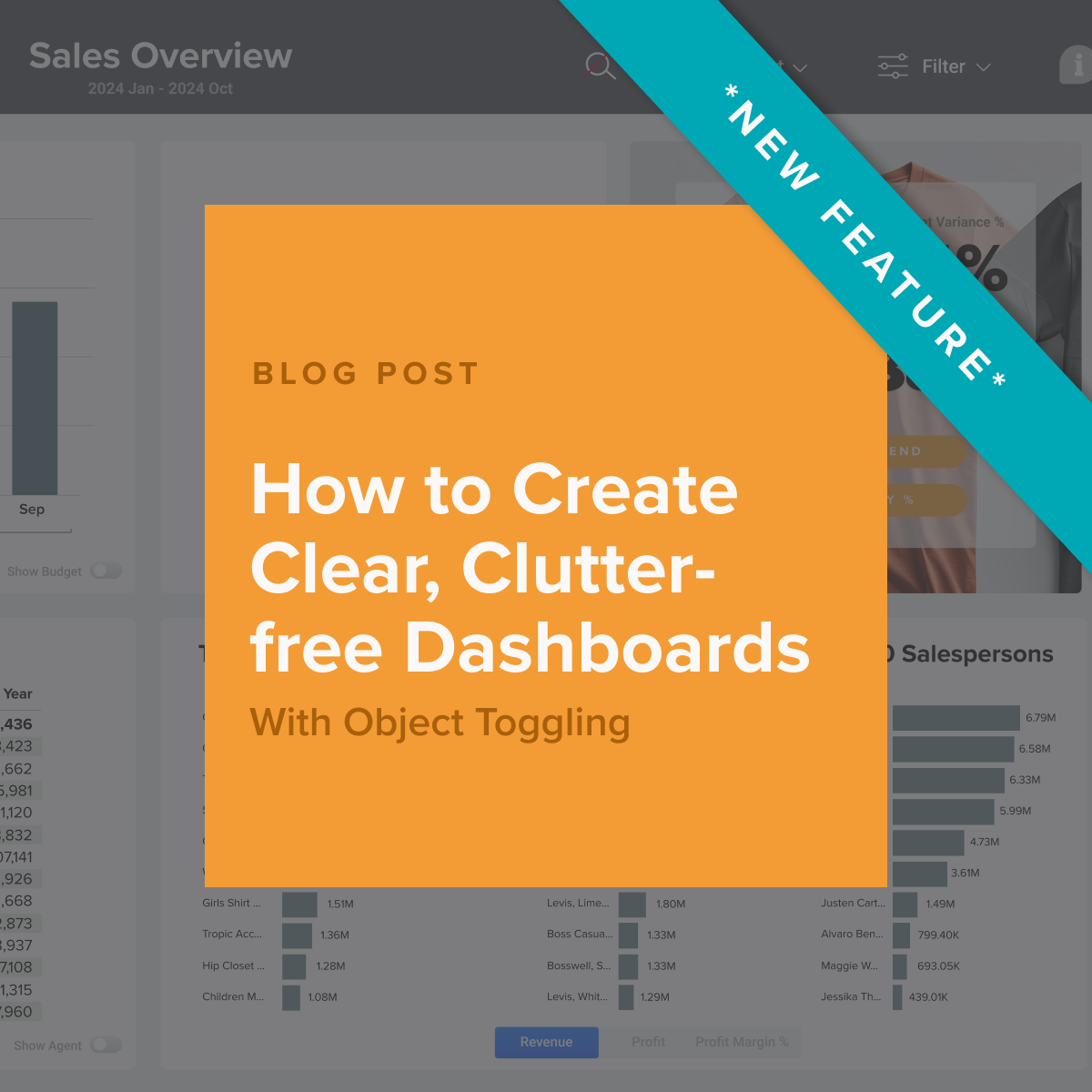- blog
- Explore Real World Use Cases for TARGIT’s Filter Delegates Feature
Explore Real-World Use Cases for TARGIT’s Filter Delegates Feature


We’re always working to add new features and enhancements to TARGIT Decision Suite, all designed to help our customers unlock new analytics capabilities and extract even more business insights from their data.
One of these features is Filter Delegates, which was first released in April 2024, with several subsequent refinements throughout 2024 to enhance the feature’s functionality and overall user experience.
The Filter Delegates feature allows users to filter a specific set of data, then turn the initial result (known as a dimension member) into a new filter that can be used to identify and analyze contextual data.
In September 2024, we hosted a Filter Delegates Tips & Tricks webinar, where I explained the concept of the Filter Delegates feature, walked through the activation process, and shared several inspirational use cases for sales, HR, and more.
This blog provides a summary of the technical information and use cases we shared in the webinar, which you can also watch on-demand here.
What is the Filter Delegates Feature?
Sometimes, when you apply criteria to your data and you get a result set on a specific dimension, you would like to use that result set as a criteria to pass on as a new filter.
The Filter Delegates feature makes it possible to configure any object in TARGIT to drill-down to a specific dimension within a data set. This generates a subset of dimension members, which can then be used as a filter for all other objects. This functionality is especially valuable for conducting basket analysis or obtaining contextual information related to a specific dimension.
Think of it this way: you may apply criteria to your customer list to see which customers purchased “Product A.” With Filter Delegates, you can then take that result set, “Customers Who Purchased Product A,” and use it as a filter on another data set, such as a list of all your other products. That way, you can see what other products were purchased by the customers who purchased Product A.
ALSO READ: Blog Post - Uncover Powerful Contextual Data With Filter Delegates
How to Configure and Use Filter Delegates in Data Analysis
Filter Delegates is activated at the object level, so you’ll start by selecting a specific object like a table, graph, API, etc. Drill on your object of choice to select one of the values within it. Then, point to a specific attribute to create a Filter Delegate.
I might start by clicking on a certain product name and identifying the customers who purchased it. Then, I want to carry that result set over as a new filter, so I will delegate “Customer Name” as a new filter. I can use that new filter to pull up a new data set, such as a list of other products purchased by those customers or a list of how much revenue was generated by that list of customers.
TARGIT customers are already using Filter Delegates to:
- Test hypothetical scenarios using Designer-only dashboards
- Create dashboards for Consumers that illustrate specific scenarios
- Enhance analysis by combining Filter Delegates with other features like Local Filters, Mashup Dimensions, and Required Criteria.
As you explore and begin experimenting with Filter Delegates, keep in mind that it won’t be at the core of all analyses you do in TARGIT. It’s built to illustrate specific scenarios and stories occurring within your operations.

Key Considerations for Working With Filter Delegates
In the back end, be careful with the measures. The delegated filter is dictated by the measure at hand in a specific object. If you keep all measures in the dashboard the same, you’ll generate clear, easy-to-understand results. But things can get complicated and confusing when you start mixing measures within a single dashboard. Another thing to avoid is decorations on dimensions, which can also muddy your results.
When it comes to designing dashboards for Consumer users, your primary goal should be clarity. Help your users understand what’s going on in the report by guiding them through the drill process.
Filter Delegates is not a normal drill, so we recommend adding text to nudge your users through the process and explain the numbers included in the results. Additionally, you could consider using features like Required Criteria to reduce the number of errors and missteps that may occur when completing a Filter Delegate drill.
Real-World Use Cases for TARGIT's Filter Delegates Feature
There’s an endless list of potential use cases and applications for Filter Delegates feature, and many of the ones listed below have been brought to us by customers who’ve already begun experimenting with this powerful feature.
We hope these use cases will serve as inspiration for how you leverage Filter Delegates inside TARGIT, and we invite you to share ideas, new use cases, and suggestions with our team to help us continually enhance this and other complementary features.
You can see technical walkthroughs for these use cases on TARGIT Community: See all Filter Delegates use cases and access the demo data for each.
#1 "Basket Analysis" Style Drill – Complexity Level: Simple
This use case helps you find other people or entities in the same group as those identified in your first drill. For example, you can use it to answer questions like:
- These customers purchased Product A. What other products did they buy?
- These employees called in sick on Monday. Which other weekdays were they absent from work?
- These employees completed the first required training course. What other trainings did they complete?

Example 1A: This dashboard includes text designed to guide Consumer users through the Filter Delegates drill. They will begin by filtering attendance data by time period, employee department, or employee age. Then, they should select a specific absence reason to see what other absence reasons the population has used. On the right, we can see that employees who used the “Undefined Sick” absence code also used three other codes. Additionally, we can see the total hours that that specific population was absent for each code.
#2 Drill to Answer, “What Are They Doing Now?” – Complexity Level: Simple
This type of drill creates a result with a local time filter, then delegates that group as a filter. It combines Filter Delegates with Local Filters to examine a certain population in another timeframe or other context. It helps analysts answer questions like:
- This group completed “Activity 1” last month. What did they do this month?
- Here's how “Product A” performed last quarter. How has it performed this quarter so far?
- This group of customers bought our top-selling product last year. What product(s) have they purchased this year so far?

Example 2A: See how employee absences have evolved over time within the same subset of employees. Start by choosing a reason for absence from more than one year ago to get a list of employees who were absent 13-24 months ago, and the other absence codes they used during that timeframe. Then, see the absence codes those same employees used within the past 12 months.
#3 Drill to Answer, “What’s the Replacement?” – Complexity Level: Intermediate
This drill example is similar to the one above, but it focuses on identifying the specific replacement actions taken by a certain population rather than how those replacement actions have evolved over time.
Here, we introduce a new type of Filter Delegate drill. Rather than selecting the “Equal To” criteria we’ve used in the previous scenarios, select the “Different From” one here. This type of drill is helpful for answering questions like:
- Which other products are our customers buying instead of Product A?
- Which other reports do our employees use instead of the official sales report?

Example 3A: See which document people are using besides your selected document type, such as a specific report or dashboard in TARGIT. Start by filtering down into a specific document type, set of users, or client type. Then, select your document. Behind the scenes, this drill identifies which users did NOT use the document you selected. Then you will see a list of the documents these users used instead on the right-hand side of the screen.
#4 "This Not That” Drill – Complexity Level: Intermediate
This use case combines the “Equal To" and “Different From" Filter Delegates to help you answer, “Who did this, but not that?” For example, click on a product name in the Equal To list to see the customers who bought the product, then on the Different From list, choose a second product name.
The result? You’ll see a list of who bought the first product but NOT the second. You can use this information to identify upsell opportunities with complementary products or replacement parts.

Example 4A: See which customers purchased Product A, but not Product B. Start by selecting a product on the Equal To list, such as the Men’s Hat. Then, select a product on the Different From list, such as the Men’s Scarf. On the resulting filter, you’ll see which customers bought a hat but not a scarf.
#5 "What’s New?” Drill – Complexity Level: Advanced
Use this drill to see who’s joined a specific group of users or entities over a pre-defined time period, aka, “what’s different in this group?” For example:
- These customers bought the product last year. Which customers apart from this group bought that same product this year?
- This list of employees did NOT use the “Undefined Sick” absence code two years ago. How has this list changed in the last 12 months? More specifically, who’s been added to it?

Example 5A: See which employees have been long-term absent in the past month. Use a local filter of ”Last Month” on the left to see who took a long-term leave of absence during that time period. Then, use the table on the right with the local filter ”This Month” to see who did NOT take a long-term leave last month, but DID take it this month. We can see that five new employees have reported to be long-term absent this month.
#6 Drill to Examine Data Across Multiple Data Sources – Complexity Level: Advanced
In this scenario, start by creating a Mashup Dimension to combine data from two different data sources via a common dimension. Then, use Mashup Dimensions and Filter Delegates in tandem to answer questions like:
- Do any of our top 100 customers (CRM data) currently owe us money (financial data)?
- Out of our top 100 customers (CRM data), which ones purchase fast-moving products (supply chain data)?

Example 6A: See which citizens in a specific demographic owe a debt or are recorded in your municipality’s legal system. One database stores data on age groups and marital status of the citizens. Another database holds information on citizens in debt problems with the city. The third database has information on citizens in trouble with the legal system. Start by creating a Mashup Dimension to link the databases together, then use the Filter Delegate feature to set up a filter that‘s delegated to the Mashup sample dimension. Once the table has been created, select the 40-44 years old age group, and ”Married” marital status. Then, see how many of the citizens in that group owe debt (8 people) and how many are recorded in the legal system (14 people).
#7 Examine Fact Tables With Non-Shared Dimensions – Complexity Level: Advanced
There may be times when you need to compare data across multiple fact tables with non-shared dimensions.

With cascading Filter Delegates (similar to bi-directional dimensions), you can actually improve your data model by connecting your data and enabling cross-table analysis.

Example 7A: Understand how employees’ reasons for absence and tenure relate. In this case, the only shared dimension is employee name, but absence reasons are not directly related to the fact table where the seniority numbers are located. So, when you choose a certain absence reason, the table generates a list of employees as a result set. Filter Delegate helps you pass the list of employees with a certain reason for absence as a filter and learn about their seniority. Now, you can pick a reason for absence and see a list of the employees who have used it, along with how many years they‘ve been with the organization.
Upgrade Your TARGIT Solution to Unlock the Latest Features
Ready to bring Filter Delegates and other new features to your TARGIT solution? As mentioned during the webinar, we’re offering a Complete Upgrade Package to our customers, featuring TARGIT Decision Suite – 2024 Edition.
Move to the latest version of TDS in the cloud to enjoy new features, enhanced performance, and regular updates and bug fixes. Visit our Upgrade page to get the details or reach out to your TARGIT Account Manager to learn more about this limited-time offer!




